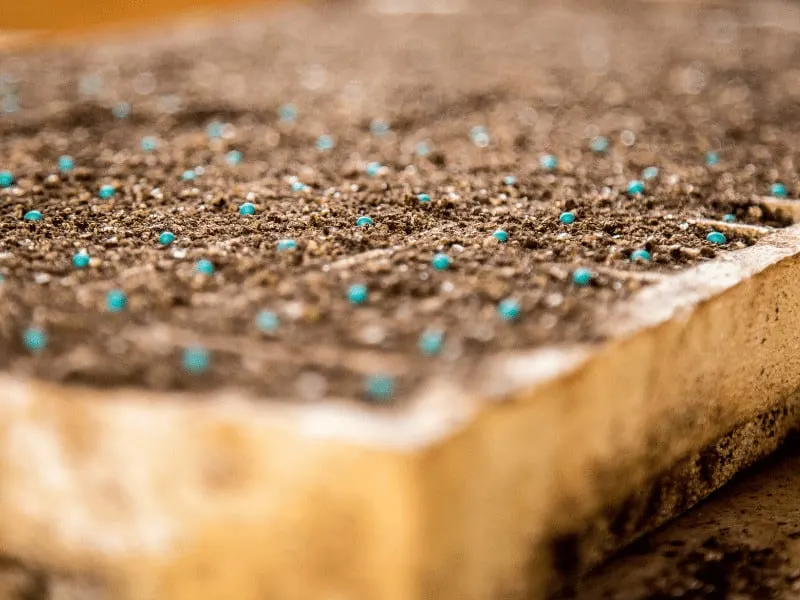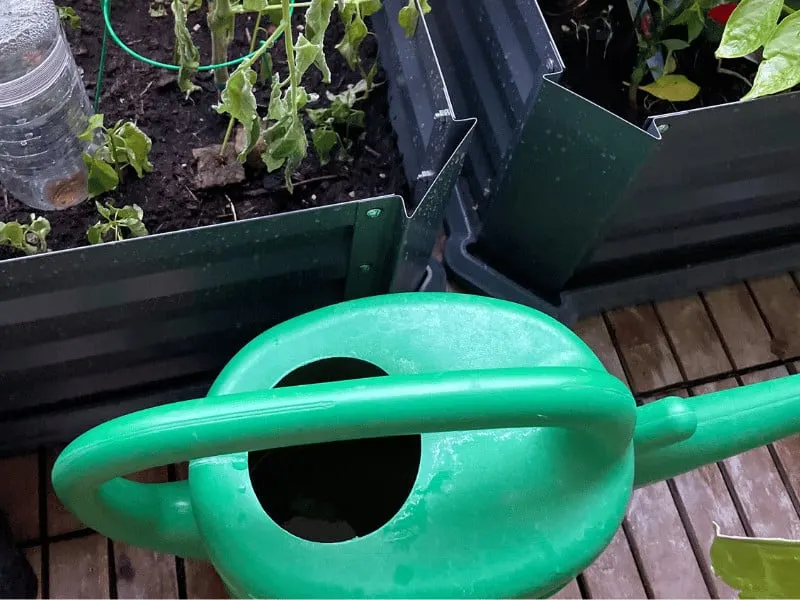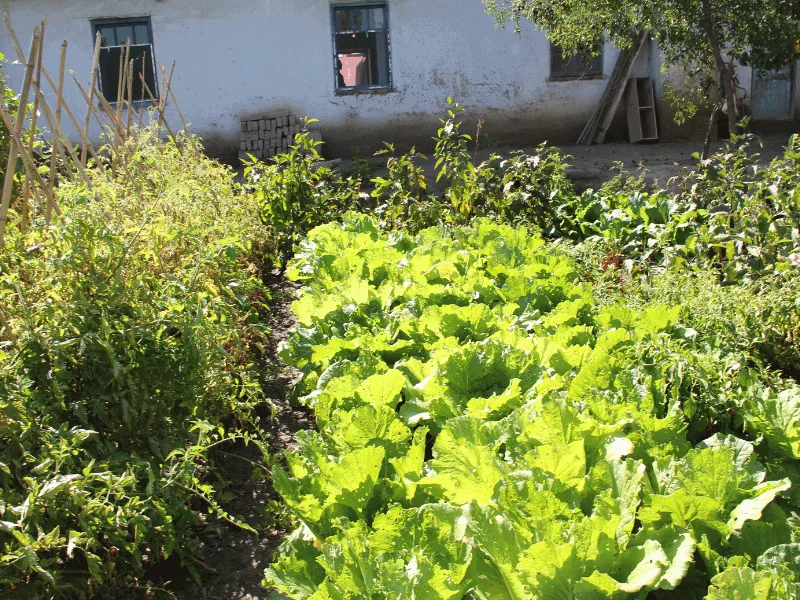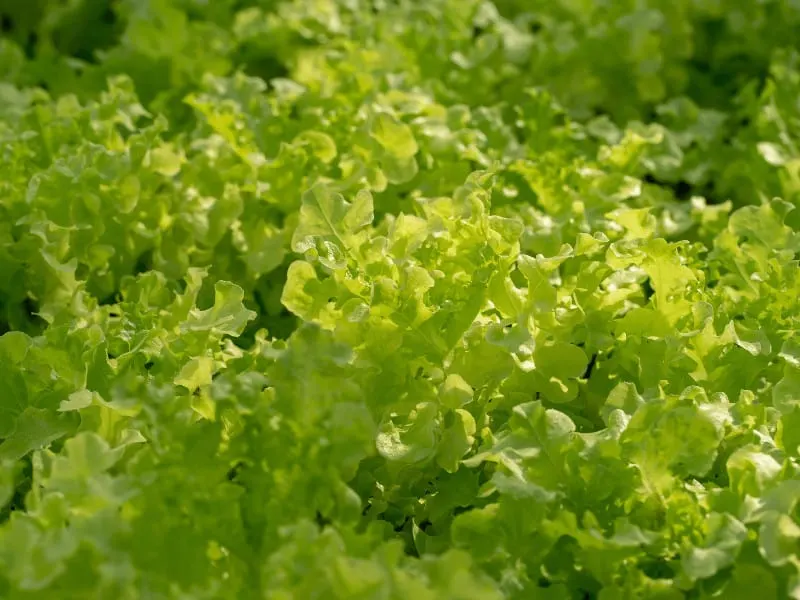If you’re considering growing lettuce (Latin name Lactuca sativa) this year, you must first understand how much water it needs.
The water content of lettuce is approximately 96 percent. If you think about it, that’s quite a bit of water.
But just exactly how much water does lettuce need?
Read below and find the answer, several lettuce-watering tips, and more!
Table of Contents
How Much Water Does Lettuce Need?
Lettuce needs water twice a week. Lettuce plants require around nine inches of water (23 cm) per season. Mature lettuce needs regular watering at least every four to five days. Lettuce should not be watered daily. The exception is the first two weeks after planting which may require daily watering. After the lettuce sprouts, reduce to approximately twice per week.

How often to Water Lettuce?
Lettuce seeds need to be watered daily. Maturing lettuce needs water every three to four days, and if the weather is hot or dry, every day or two. Lettuce is a plant that requires a good bit of water through the season and a constant supply.
You may also opt to water lettuce via driplines and other forms of irrigation. In this case, avoid watering overhead with sprinkler systems and use pipes or hoses that deliver water straight to the base and root zone of the plants.

How often to Water Lettuce Seeds? Water Lettuce Seeds Daily
When planting lettuce seeds, soak the soil until it is fully saturated with water, plant the seeds, and water it again every day for 10 to 15 days. Once the seeds become lettuce sprouts, reduce to regular watering sessions twice weekly
Lettuce is one of the most common vegetable plants to plant. Remember to water the soil thoroughly when planting lettuce from seeds, which is the most common way to do it (you can also grow lettuce from cuttings and stumps!).

Does Lettuce need a lot of Water?
Each season, lettuce plants require around nine inches of water (23 cm). Lettuce plants have short roots that don’t grow deeply into the soil. That means they need more water than other plants with such shallow roots.
When you water your lettuce, watch the water absorbed into the soil. Ensure you soak the top of the soil and its shallow roots thoroughly each time.

How much Water does Romaine Lettuce need?

Water Romaine lettuce frequently in the first 2 weeks says Georgie University. I water my Romaine lettuce seedlings daily using a spray bottle in the beginning. Then once it produces mature leaves, I water it every 4 to 5 days.
Romaine lettuce, or Roman lettuce, according to the University of Florida needs slightly humid soil.
How much Water does Iceberg Lettuce need?

Iceberg lettuce needs to be watered twice per week. Ensure the soil stays humid. I water my Iceberg lettuce more often on hot days. If the soil is dry down to 2 inches (5 cm) I water my Iceberg lettuce ignoring the general guideline.
Take the Sun into Consideration When Watering Lettuce
The more light your lettuce gets, the more frequently you may need to water it. Lettuce needs at least 6 to 8 hours of sunlight but does well with more sunlight.
Depending on where you plant your lettuce, it may have more or less exposure to the sun. Consider how much sunlight your lettuce receives each day and how much it contributes to the rate at which the soil dries up.
If you have lettuce growing in two areas that receive different amounts of light, ensure that you water each one according to how much light it gets. Stick your finger in the soil every two or three days and ensure the soil isn’t completely dry. If the soil is dry, go ahead and water your lettuce.
Avoid Overwatering or Underwatering Lactuca sativa

Lettuce is easy to grow. The most common way to mess up with growing lettuce is overwatering or underwatering it.
Both underwater and overwatering lead to disaster with lettuce due to its high water content. Overwatering lettuce leads to rotting leaves, bacteria, and fungus such as root rot. Underwatering leads to crispy and shriveled-up lettuce plants.
Water Lettuce Extra When It’s Hot!

Increase your lettuce watering sessions to every other day rather than twice per week. If the weather is extra hot or dry for long periods, says
Likewise, in extreme conditions, you may need to water your lettuce every morning to ensure it survives the heatwave.
The morning is the best time to water lettuce, according to Piedmont Master Gardeners, as it will absorb more nutrients and have all day to dry off.
Protect Your Lettuce From Rain or Snow
Protect your lettuce with overturned pots when the weather forecast predicts a storm, prolonged rain, snow, or frost periods. A cover helps avoid overwatering, rotting leaves, and root rot.
If you plant lettuce in September, this tip may be extra-helpful when the first frost appears.
Mini-greenhouses, plastic bags, umbrellas, and buckets are popular for protecting lettuce from rain or snow. Anything that keeps the moisture from covering the plants or saturating the soil around their root zones works.
Remember to remove the cover from your lettuce when the rain stops, especially if the temperature increases. Otherwise, you may end up with wilted or rotting lettuce.
How to Water Lettuce
Direct the water flow to the lettuce plants’ base and root zone, allowing the ground to absorb plenty of water before moving on. Avoid watering the tops of lettuce plants as it may cause them to rot and attract pests.
Watering lettuce is simple but needs to be carried out properly. All you need is a garden hose, a watering can, a clean freshwater source, and a steady hand (or irrigation system).
What Does Overwatered Lettuce Look Like?
Overwatered lettuce is pretty easy to spot; it looks slimy and yucky and yellow, brown, and even black. The lettuce may look like it’s rotting or melting because, more or less, it is doing just that. Remove the mushy parts of overwatered lettuce quickly to prevent root decay.
These were my top tips on watering lettuce. Thank you for reading!

Daniel has been a plant enthusiast for over 20 years. He owns hundreds of houseplants and prepares for the chili growing seasons yearly with great anticipation. His favorite plants are plant species in the Araceae family, such as Monstera, Philodendron, and Anthurium. He also loves gardening and is growing hot peppers, tomatoes, and many more vegetables.


